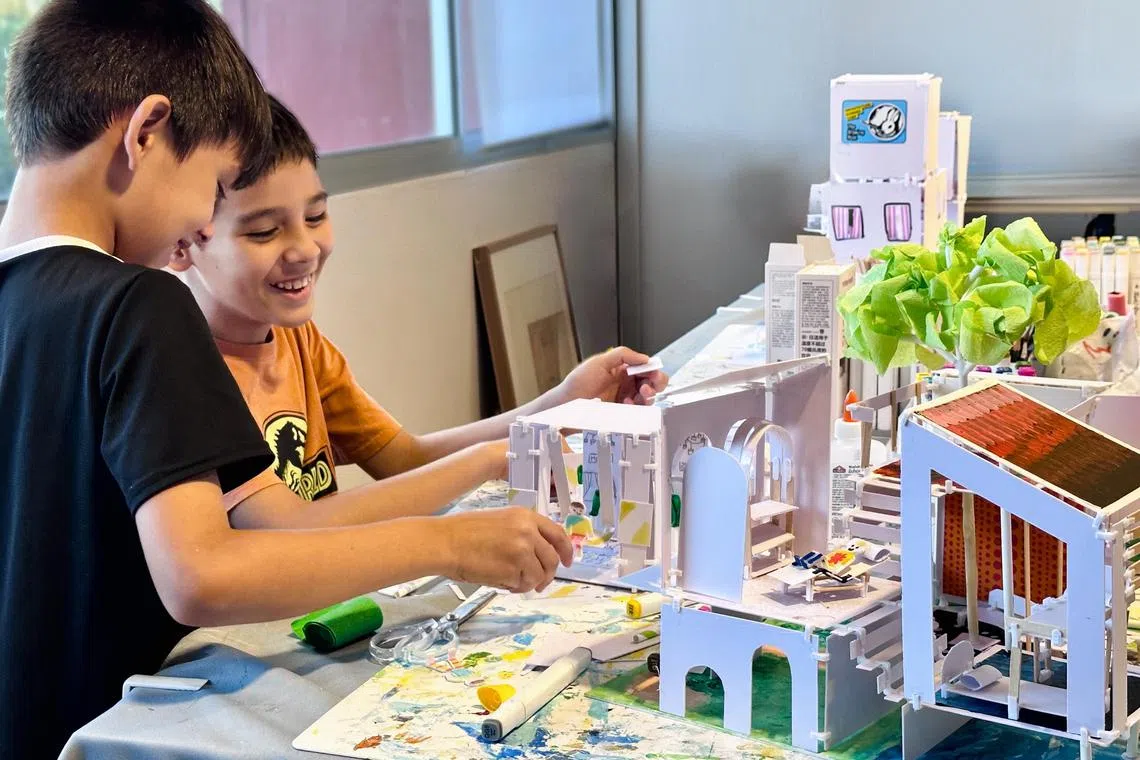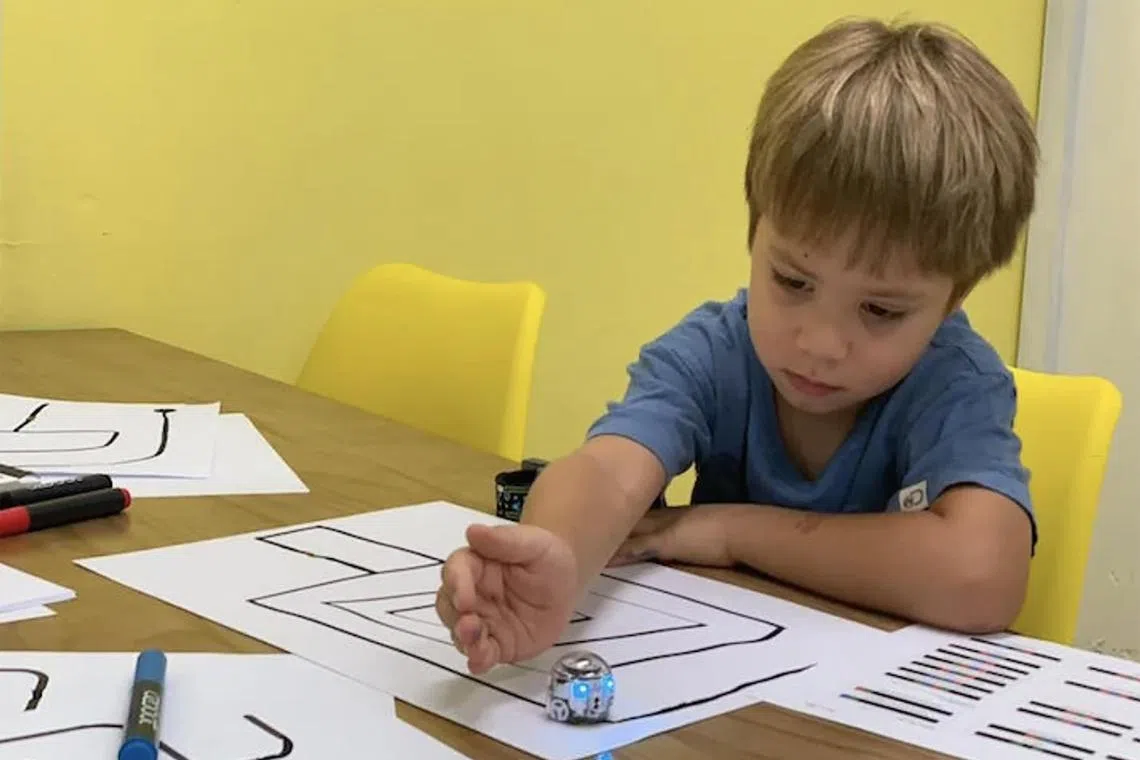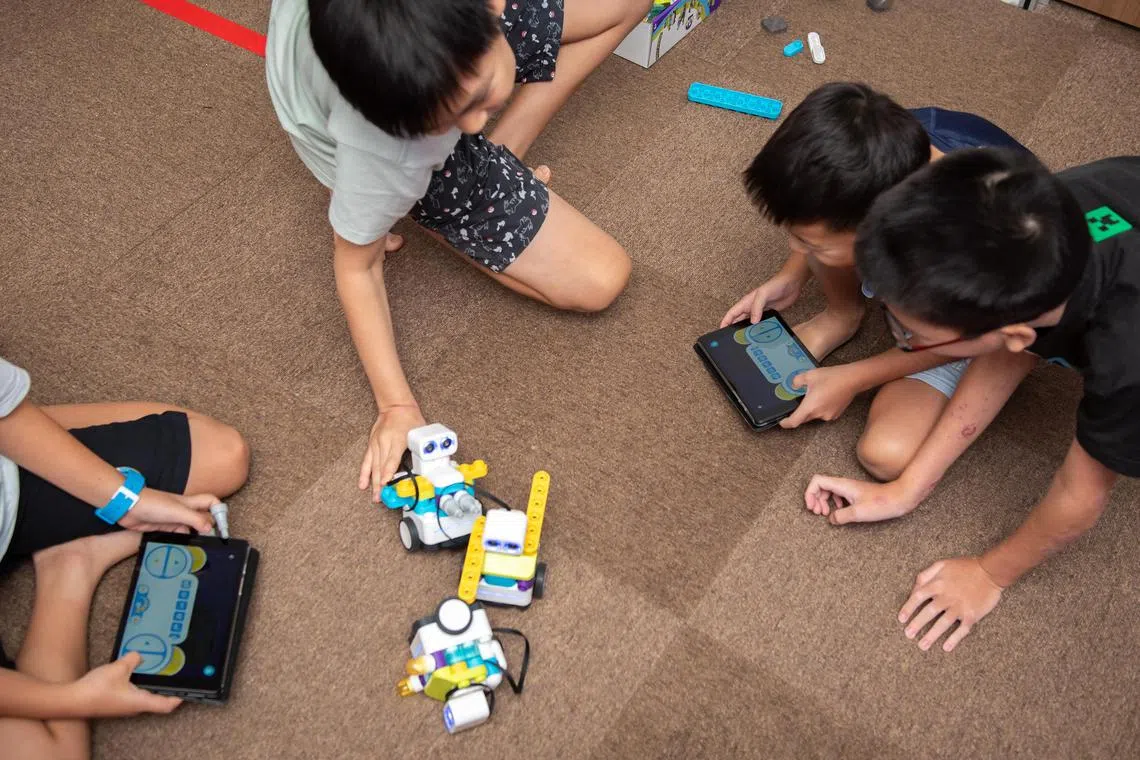Design camps for kids make learning fun
Sign up now: Get ST's newsletters delivered to your inbox

Design-themed holiday camps in Singapore such as (clockwise from top left) DesignTinkers, Charters 4 Teens, The Drawing Mint and Maker.SG.
PHOTOS: CHONG JUN LIANG, WAGA MARI, THE DRAWING MINT, MAKER.SG
Follow topic:
SINGAPORE – Holiday camps in Singapore run the gamut from nature-based romps to more sedate dance and drama classes, but design-themed camps are now enjoying greater popularity.
When schools close for the holidays from May 31 to June 29, many children will be learning about how design can help shape their future.
At home-grown company Maker.SG, children as young as three will assemble functioning robots which they can take home.
Other children and teenagers aged seven to 18 can choose from more challenging projects.
At The Drawing Mint, young ones learn how to combine art with architecture in fun-filled day sessions.
Another holiday highlight is to go offshore to design a life-saving raft aboard a spacious catamaran, as part of an immersive camp organised by Dutchman “Captain Martijn”.
He conducts a five-day Charters 4 Teens summer camp that sets sail from One Degree 15 in Sentosa Cove.
Over at DesignTinkers, children can build treehouses or design an eco-friendly home.
Eleven-year-old Sharanya Singh likes the creative, hands-on part of the class most.
She builds real models, solves design challenges and works with other children to come up with new ideas.
“It was fun to think like a designer, especially when designing my room, and to design an eco-friendly house,” says Sharanya, who adds that she would like to pursue design as a career when she grows up.
“The course showed me how fun and exciting design can be. I also liked how the instructors encouraged us to try new things.”
Her father, Mr Kumar Tanmay, who works in the technology sector, is impressed with the new skills she has developed after attending the DesignTinkers course.
“Not only has her creativity and confidence grown, but she has also learnt how to approach problems with a design-thinking mindset,” the 44-year-old tells The Straits Times.
“It is something of value that goes well beyond the classroom. It’s been wonderful to see her excitement at sharing her projects and explaining her ideas when she comes home.”
Another parent, Mr Kevin Chong – a chief operations officer at a digital logistics and transportation firm, who did not reveal his age – says DesignTinkers classes have opened up his son Mathieu’s mind to a world of possibilities.
“He is more aware of how architecture plays a key role in promoting environmental sustainability. This insight can guide his thinking on the subject and, hopefully, help him play an important role in shaping the future.”
For Mathieu, who turns nine in June, the classes are like a journey of discovery.
“I get to do creative projects and see my imagination come alive,” he says. “And I want to design more of my favourite things.”
So, how important is it for children to ditch their digital devices and screen time to go off-grid?
According to Dr Alison Snodgrass, a paediatrician at Parkway East Hospital in Joo Chiat, participating in craft-based, hands-on activities helps young children develop fine motor skills while also supporting kinaesthetic learning.
Kinaesthetic learning, also called “learning by doing”, is centred on discovery and understanding through movement and tactile activities. This active learning process allows children to grasp design concepts when they physically engage with their environment.
“Just as important for children is to work on creative projects in a relaxed and encouraging environment that nurtures emotional resilience, patience and a sense of accomplishment,” says Dr Snodgrass, who has been practising medicine for more than 20 years. She has a special interest in preventive healthcare for children and adolescents.
“This helps lay the groundwork for stronger learning habits and greater self-confidence in both academic as well as everyday settings.”
The Straits Times looks at four ways to enjoy art, design and architecture holiday camps.
Helping kids tinker beyond the classroom

DesignTinkers founder Tessa Ng (centre) and assistant teacher Ma Huiru conducting a class.
ST PHOTO: CHONG JUN LIANG
More parents are signing up their young children for holiday camps in design and architecture at DesignTinkers.
Founded by Ms Tessa Ng, the home-grown education provider has seen a steady uptick in enrolment since its inception in 2021.
In 2024, she saw a jump of between 30 and 50 per cent in registration in the school’s range of design and architecture classes.
DesignTinkers, which is at the artist enclave of Goodman Arts Centre in the Mountbatten precinct, also conducts classes at multiple locations such as at Agora Colearning in HarbourFront Centre.
Ms Ng has also noticed a high rate of returning pupils and is heartened by new sign-ups and over-subscription for some classes.
DesignTinkers was started with a desire to introduce a different way to learn in Singapore’s academic-centric environment, says the 47-year-old.
She graduated with a degree in architecture in 2001 from the Royal Melbourne Institute of Technology in Australia. She practised at award-winning firm Bird de la Coeur Architects before registering as an architect in Melbourne.
Ms Ng returned to Singapore to continue her professional practice at global design and architecture firms Aedas and Broadway Malyan.
She then embarked on her architectural teaching journey at Singapore Polytechnic in 2010, where she taught in the Diploma in Architecture course.
She later lived with her family in London from 2016 to 2020, where she was inspired by the Royal Institute of British Architects’ programme to introduce architecture to children in schools.
This led her to start DesignTinkers in Singapore, as a platform for children to explore and learn beyond the classroom.
“We wanted to promote visual and kinaesthetic learning through our creative hands-on activities that combine the technical craft of architecture with the imaginative exploration of art and design,’‘ she says.
The primary aim is to introduce kids to good design, she adds, and to raise awareness of the built environment and sustainability.
The school runs classes during school holidays and on a weekly term basis. Classes are conducted by eight full- and part-time teachers proficient in art, design or architecture.
Holiday class sizes are kept small, usually between five and 12 participants, ranging in age from seven to 12. As the classes are highly interactive and hands-on, there is a low teacher-to-pupil ratio.
“We want children to understand that good design is not only about creating something that works well and looks great,” says Ms Ng. “Children as young as seven learn about design’s transformative power and how to apply design thinking to care for our environment to make the world a better place for everyone.”
A new holiday camp is introduced during the June or December holidays each year, adding to the line-up of up to 50 design and architecture creative workshops. For the June holidays, Design A Cafe has been added. Camps start at $165 for a one-day module.
DesignTinkers’ signature camps are a mainstay of the curriculum. The first is a three-day Design A Home camp, where pupils apply design thinking principles to better understand the needs and challenges of the people they are designing for. They also learn basic space planning for a home.
Participants begin by planning their two-dimensional (2D) designs on paper, and then translating those ideas into 3D models, being mindful of architectural scale, light, ventilation, views and communal landscape areas.
Another signature course is the two-day Design An Eco-Home camp, which aims to raise awareness of the importance of envisioning sustainable buildings to minimise environmental impact.
Lastly, the two-day Design My Room camp teaches participants how to maximise their bedroom space through a basic understanding of floor planning, furniture types, materials, colours and textures.
They will also personalise and decorate the interior spaces, learn model-making techniques and transform everyday materials such as cardboards, cards and bottle caps into unique bedroom model prototypes.
“Our programmes are also offered in primary and secondary schools through the Ministry of Education,” adds Ms Ng. “It is our hope that design can be taught to more students than those who sign up for private classes.”
Info: To register, go to designtinkers.sg
Aye, aye Captain, and away we go

Captain Martijn Piket teaching a child to steer the Waga Mari vessel as part of the Charters 4 Teens holiday camp.
PHOTO: BRENDA ENG
Children get to dive, swim and scream in excitement on Captain Martijn’s yacht-bound Charters 4 Teens holiday camps.
Besides learning how to tie the fisherman’s knot and design a raft using easily available materials – including tyre tubes, wooden sticks and ropes – camp participants are encouraged to have lots of fun.
Mr Martijn Piket, who is 52 and owns Waga Mari, a 14m luxury vessel with twin hulls, is better known by his skipper’s persona.
The yacht’s maiden voyage was in January 2021, primarily for exclusive charters for day trips, sunset cruises and overnight bookings. It continues to receive five-star Google reviews for its quality of service, food and beverage, and overall guest experiences.
The capacious catamaran, which is moored at One Degree 15 in Sentosa Cove, accommodates up to 28 guests with a crew of two on day trips.
It has four air-conditioned en-suite cabins where up to six guests can sleep comfortably on overnight trips.

Charters 4 Teens participants learn how to tie sailors' knots.
PHOTO: WAGA MARI
Mr Piket hit upon the idea for Charters 4 Teens in early 2021, after he saw how much children enjoyed cavorting in the water on outings during the Covid-19 pandemic.
“On several chartered trips for adults, I saw how their children became uninhibited when they jumped off the boat and played in the water, without having to worry about wearing masks or observe social distancing,” says Mr Piket, a Dutchman with a 15-year-old daughter. He has been a permanent resident since 2012.
“During this time, parents – often just one parent and a child – would book trips for their kids to have fun. The kids enjoyed jumping off the boat, playing around on a floating mat or paddle-boarding.”
The charters are available for children aged nine to 15 who are able to swim. The five-day camp costs $875 a child, and includes food and drinks. The yacht leaves One Degree 15 at 9am and comes back at 2.45pm, from Mondays to Fridays.
Besides water sports, children are also taught how to form knots such as the bowline and clove hitch, which are handy for the outdoors when pitching a tent.
There is also a raft-building session where children sketch a raft design and think of ways to make it float using car tubes, wooden sticks, ropes and a variety of knots.
The exercise helps them glean the basics of designing rafts, including materials, buoyancy and structural strength.
The children then split into teams to build the rafts and race them.

A team of Charters 4 Teens participants discussing raft design.
PHOTO: WAGA MARI
Mr Piket feels it is healthy for children to be close to nature in groups on land as well as in the sea, since it builds confidence, teamwork and stamina.
“Most important is that the children make new friends and are fully immersed in the off-grid programmes,” he adds.
“It is one of those rare moments when they are so busy having fun, they totally forget about their mobile phones or tablets.”
Info: Waga Mari Yacht Charters Summer Camp 2025 is held for four weeks in June and July. Call or WhatsApp Mr Piket on 9640-6311 or go to wagamari.com/pages/holiday-camps
Combining the strengths of art and architecture

(From left) Brothers Lazarus Lim, eight, and Leonardo Lim, 10, working on a project at The Drawing Mint’s Art + Architecture Camp.
PHOTO: THE DRAWING MINT
Children and teens at The Drawing Mint are taught to meld art with architecture – two disciplines that, at first, seem at odds with each other.
Art is about form and typically created on the spur of the moment, focusing on emotional and aesthetic expression.
Architecture, on the other hand, is about how form serves distinct functions, such as providing shelter and facilitating activities.
But Ms Mae Micaela Tay, the Singaporean founder of The Drawing Mint, says the school’s Art + Architecture programme is carefully designed to integrate both disciplines.
In 2019, Ms Tay, who has more than 20 years of experience teaching art, partnered Thai co-founder Satawat Buranasilapin, an award-winning designer with a master’s degree in architecture from Chulalongkorn University in Bangkok, Thailand. Their course has seen high attendance rates since its inception.
“Architecture concepts can be dry and less approachable for young children, but with the infusion of fine arts elements, children are able to enjoy and express their ideas, deeply integrating them into their architecture projects,” says Ms Tay.
The course, which is conducted in small classes with a ratio of one instructor to five students, is aimed at young children and teenagers ranging in age from four to 18.
Course fees range from $345 for the Architecture camp to $510 for the Art + Architecture camp.
There are regular weekly classes and holiday camps throughout the year. They cater to a diverse group comprising Singaporean and foreign students, as well as home-schooled children.
The Drawing Mint has two local branches in River Valley and Joo Chiat, and a newly opened school in Bangkok.
The curriculum – which is drawn up by Ms Tay, 45, and Mr Satawat, 49 – includes proprietary design tools developed in-house.
Ms Tay graduated with a bachelor’s degree in early childhood education at the University of South Australia. Her teaching values are influenced by the Reggio Emilia Approach, an Italian philosophy which uses art as a tool to observe, make meaning and create new ideas.
The approach treats children as competent and curious learners, capable of constructing their own knowledge and developing skills through hands-on experiences and interactions.
Ms Tay was also trained at the Nanyang Academy of Fine Arts in Singapore, and overseas at The International School of Painting, Drawing and Sculpture in Umbria, Italy, as well as The Florence Academy of Art / Sweden.
The tools and teaching processes at The Drawing Mint are created to help children build ideas into a model, allowing them to expand and explore infinite possibilities through imagination.
The founders observed that over the span of five years, children were able to envision new projects and ways of playing with the tools in the system, as well as reinterpreting what they had originally designed.
“The primary objective for children to learn art or architecture design is not only to prepare them to be future artists or architects,” says Mr Satawat.
“The deeper purpose is to train their mind in the architectural principles of creating a project from start to finish. Regardless of what they grow up to be – a future financial investor, entrepreneur, psychologist or scientist – they can apply the same building principles in any field.”
Ms Tay says The Drawing Mint’s well-being approach allows young learners to combine the functional and logical thinking of architecture with the emotive and intuitive elements of fine arts, so they can develop empathy and resilience.
She adds: “It is a beneficial programme to top off academic learning. We are in a rapidly changing world. Equipping the young with adaptability and creativity is foundational for a modern education.”
Info: To register, go to thedrawingmint.com
‘Minds-on, hands-on’ at robotics class for tots

A young camp participant doing Ozobot colour coding to instruct a small robot to perform different actions.
PHOTO: MAKER.SG
Getting a head start in robotics can mean picking up science, technology, engineering and mathematics (Stem) courses from as young as three.
Maker.SG, a home-grown maker space founded by four Singapore-based entrepreneurs in 2022, has a range of Stem programmes for the school holidays for tots aged three to five that includes making Lego robots and chibitronics.
Chibitronics is a system of peel-and-stick circuit components that allows children to try coding through electronic projects without complex soldering or wiring.
The stickers contain embedded circuits that can easily be applied to surfaces such as paper or fabric. These circuits are then lit and animated through a microcontroller called a Chibi Chip.
From this starter course, children can go on to learn simple robotics, such as making walking Lego robots, at Maker.SG’s four centres in River Valley, Bukit Timah, Thomson and Joo Chiat.
A Maker.SG spokesman says robotics is a hands-on way to pique children’s interest in Stem, and lay the groundwork for computer science and engineering skills in a practical setting.
“In robotics classes, children as young as three will get to design, prototype and build real robots,” he says.
Courses are priced flexibly for half-days and full days. A half-day module costs from $100.

Participants in a holiday camp at Maker.SG activating their robots via remote control.
PHOTO: MAKER.SG
The spokesman adds: “Kids develop their problem-solving skills and get an early introduction to a booming industry which is set to grow exponentially in the future.”
He says that unlike store-bought robots, making one’s own robot demands concentration, skill and creativity.
“When kids build their own robot, they learn how to think like engineers, solve problems and understand the ‘why’ behind the ‘wow’.
“It’s hands-on, minds-on learning, and that’s what sticks with young children long after the course is over.”
Info: To register, go to maker.sg
Designer and lifestyle journalist Chantal Sajan writes on design and architecture.


